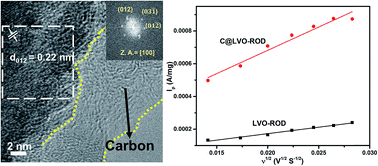Morphology controlled lithium storage in Li3VO4 anodes†
Abstract
Li3VO4 (LVO) anode materials with controllable morphologies ranging from spherical-assemblies, single-crystal nanorods, and flower shapes to bulk-shapes were fabricated via a solvothermal approach using different alcohols (i.e., ethanol, methanol, propanol, and butanol). XRD, SEM, BET, Raman and FTIR and galvanostatic charge/discharge measurements were carried out to correlate their structure/morphology with their electrochemical characteristics. The experimental results reveal that both structure and morphology play important roles in the Li+ ion storage of LVO, which degrades in the sequential order from nanorods, to spheres, to flowers and finally to bulk. The LVO nanorods are hierarchical and have a small particle size, high specific surface area, and high crystallinity; thus, they exhibit the largest Li+ ion diffusion coefficient and best electrochemical performance among the four electrodes. Moreover, coating carbon on the single-crystal LVO nanorods further enhances their Li+ ion storage ability. Consequently, the carbon-coated LVO nanorods deliver a high reversible capacity of 440 mA h g−1 at 0.1 A g−1 with good cycling stability and demonstrate great practical application. In addition, the results promote a better fundamental understanding of the Li+ ion storage behavior in LVO and provide insight into the optimal design of LVO and other vanadium-based electrode materials.



 Please wait while we load your content...
Please wait while we load your content...